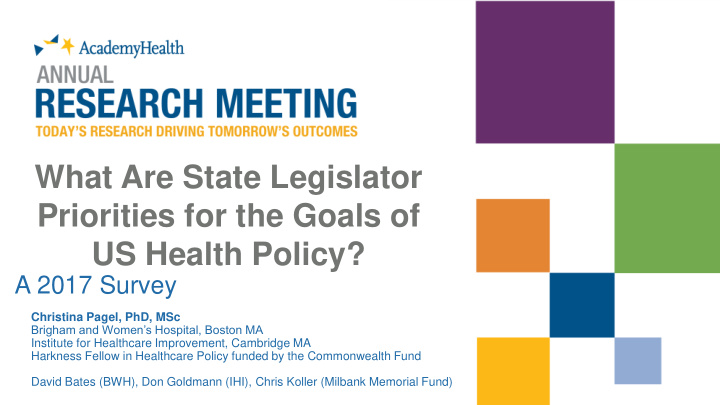



1 What Are State Legislator Priorities for the Goals of US Health Policy? A 2017 Survey Christina Pagel, PhD, MSc Brigham and Women’s Hospital, Boston MA Institute for Healthcare Improvement, Cambridge MA Harkness Fellow in Healthcare Policy funded by the Commonwealth Fund David Bates (BWH), Don Goldmann (IHI), Chris Koller (Milbank Memorial Fund)
BACKGROUND 2 • The Affordable Care Act (ACA) → the American Health Care Act (AHCA). If durable reforms require bipartisan support, they need to meet the goals of both parties. • What do state legislators believe are the most important goals of health policy? • State legislators are “ the closest possible comparable sample to members of Congress”* • Survey designed to ask legislators to prioritize among a given set of goals. * Butler DM, Powell EN. J Polit. 2014 Apr;76(2):492 – 505
SURVEY 3
RESULTS: RESPONDENT CHARACTERISTICS 4 Response rate Affiliation All Asked (N=2973) Responded (N=376) (Overall = 13%) Republican 55% 181 (48%) 11% Democrat 44% 192 (51%) 15% Other 1% 3 (1%) 10% Republicans and Democrats rank significantly differently (p<0.0001*) so need to examine by party . No significant differences* in ranking between region, by chamber or by committee type. * MANOVA test on mean ranks; Wilcoxon signed ranked or Kruskal Wallis tests for each goal, Bonferroni corrected for multiple comparisons
RESULTS: REPUBLICANS, N=181 5 LEAST MOST IMPORTANT IMPORTANT Point position derived from data. Goodness of fit: 95%
RESULTS: REPUBLICANS, N=181 6 LEAST MOST IMPORTANT IMPORTANT Clusters identified using cluster linkage
RESULTS: REPUBLICANS, N=181 7 GOVERNMENT RESPONSIBILTY Improving overall health Reduce costs LEAST MOST IMPORTANT IMPORTANT The AHCA? Addressing healthcare delivery FREE MARKET Smaller government Cluster and axis interpretation
RESULTS: DEMOCRATS, N=192 8 LEAST MOST IMPORTANT IMPORTANT Point position derived from data. Goodness of fit: 94%
RESULTS: DEMOCRATS, N=192 9 LEAST MOST IMPORTANT IMPORTANT Clusters identified using cluster linkage
RESULTS: DEMOCRATS, N=192 10 MACRO LARGE SCALE SYSTEMS? Smaller government Reduce costs Improving health and equity LEAST MOST IMPORTANT IMPORTANT The ACA? Addressing healthcare delivery PATIENT FACING / LOCAL SYSTEMS? Cluster and axis interpretation
CHALLENGES AND OPPORTUNITIES 11 Payment Payment reform? reform? DEMOCRATS REPUBLICANS • Difficult to reconcile difference on the role of government in health care • Possibility for bipartisan work on costs • Also for bipartisan work on healthcare delivery where it does not conflict with higher priority goals
FINAL THOUGHTS 12 DEMOCRATS REPUBLICANS • Designing policy • Evaluating policy • Messaging policy
METHODS: ANALYSIS – MAPS AND CLUSTERING 13 3D Number of dimensions = GIVEN RANKS GOAL Legislator 1 Legislator 2 Legislator 3 number of respondents X value Y value Z value (in this example 3) D: Reduce overall costs 2 1 2 E: Reduce individual costs 1 2 1 F: Overall health 5 4 5 H: Reduce disparities 6 5 6 I: Increase access 4 6 4 L: Reduce government involvement 3 3 1 Mathematical technique 2D called multi-dimensional scaling (MDS) maps goals in ND space onto 2D space Clusters of goals identified using hierarchical cluster analysis It is up to the observer to interpret the clusters and their relative positions for insight
Recommend
More recommend